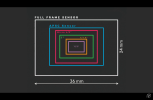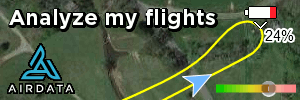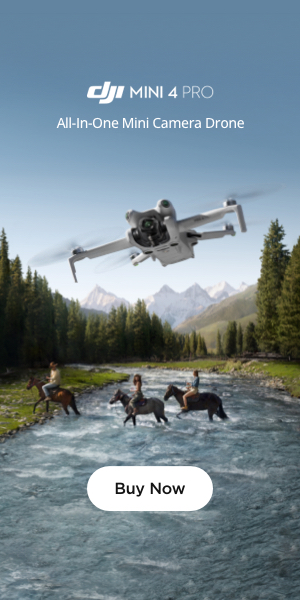The Mini 5 has leaked and is carrying a 1" sensor. So that means the sensor on the mini 5 will be better then the two secondary cameras on the Mavic 4 Pro?
You are using an out of date browser. It may not display this or other websites correctly.
You should upgrade or use an alternative browser.
You should upgrade or use an alternative browser.
Mavic 4 Sensors
- Thread starter bkushner
- Start date
Johnmcl7
Well-Known Member
Looking purely at sensor size that would be correct, the Mavic 4 tele lenses use a 1/1.3in (same as the Mini 3/Mini 4) and a 1/1.5in sensor both of which are smaller than a 1in sensor.
However I don't really see the point in comparing the tele lenses on the Mavic 4 to the wide angle sensor on the Mini 5. The equivalent lens on the Mavic 4 is a 4/3 sensor and also has variable aperture which the previous MIni's lacked, also the Mini 5 lens may not be great if they've had to make compromises to fit the bigger sensor into a small package which could impact the image quality.
I hate this sensor naming system....I really wish there was something better by now.
However I don't really see the point in comparing the tele lenses on the Mavic 4 to the wide angle sensor on the Mini 5. The equivalent lens on the Mavic 4 is a 4/3 sensor and also has variable aperture which the previous MIni's lacked, also the Mini 5 lens may not be great if they've had to make compromises to fit the bigger sensor into a small package which could impact the image quality.
I hate this sensor naming system....I really wish there was something better by now.
Bussty
Well-Known Member
The other thing you can do on the smaller 6x Camera sensor on the Mavic 4 Pro is take a FreePano effectively a wall of images to make a single image and end up with quality surpassing even your Modern DSLR single wide or slightly telephoto image. And you get to do that in the air!
Austrian Knight
New Member
YesThe Mini 5 has leaked and is carrying a 1" sensor. So that means the sensor on the mini 5 will be better then the two secondary cameras on the Mavic 4 Pro?
The 28mm on the Mavic 4 Pro does not have true MFT sensor. MFT sensor (Micro Forth Third) has aspect ratio 4:3, as shown on the diagram. However M4P sensor has aspect ratio 3:2. It might be cropped from MFT having the same width as MFT and smaller height or it might be some kind of odd size sensor.Kind of an apples to oranges comparison. 24mm FOV vs. 168mm FOV.
The 28mm on the Mavic 4 Pro is a MFT sensor.
View attachment 184290
Now we are splitting hairs. The point was not whether it is a true MFT, but that it is a significant upgrade from a 1” sensor, whether "true" or not.The 28mm on the Mavic 4 Pro does not have true MFT sensor. MFT sensor (Micro Forth Third) has aspect ratio 4:3, as shown on the diagram. However M4P sensor has aspect ratio 3:2. It might be cropped from MFT having the same width as MFT and smaller height or it might be some kind of odd size sensor.
Johnmcl7
Well-Known Member
Micro 4/3 sensors do not have to be 4:3 or any specific aspect ratio, the 4/3 measurement is a diagonal measurement across the frame and there have been other micro 4/3 sensors that are not 4:3 that have been used in micro 4/3 certified cameras.The 28mm on the Mavic 4 Pro does not have true MFT sensor. MFT sensor (Micro Forth Third) has aspect ratio 4:3, as shown on the diagram. However M4P sensor has aspect ratio 3:2. It might be cropped from MFT having the same width as MFT and smaller height or it might be some kind of odd size sensor.
The MFT design standard also specifies multiple aspect ratios: 4:3, 3:2, 16:9 (the native HD video format specification), and 1:1 (a square format). With the exception of a few MFT cameras,[6][7][8] most MFT cameras record in a native 4:3 format image aspect ratio, and through cropping of the 4:3 image, can record in 16:9, 3:2 and 1:1 formats.

Micro Four Thirds system - Wikipedia
The Mavic 4 is a 'true' micro 4/3 sensor since it has the required diagonal across the sensor, it isn't certified as micro 4/3 nor is the Mavic 3 since they aren't interchangeable lens cameras. DJI could release a drone with a 16:9 micro 4/3 sensor and it would still be a 'true' micro 4/3 sensor.
Last edited:
Thank you, that is a knowledge I was honestly not aware of. Perhaps because I never before came across a consumer MFT camera which does not have a sensor with 4:3 aspect ratio. In context of this discussion about 4/3 sensor being significantly larger than 1" sensor you are 100% correct. The reason I brought this up was that I personally did not expect the M4P to record 3:2 aspect ratio photos ( as a crop from 4/3 sensor) which to me personally came as a bit of a surprise. My bad..Micro 4/3 sensors do not have to be 4:3 or any specific aspect ratio, the 4/3 measurement is a diagonal measurement across the frame and there have been other micro 4/3 sensors that are not 4:3 that have been used in micro 4/3 certified cameras.

Micro Four Thirds system - Wikipedia
en.wikipedia.org
The Mavic 4 is a 'true' micro 4/3 sensor since it has the required diagonal across the sensor, it isn't certified as micro 4/3 nor is the Mavic 3 since they aren't interchangeable lens cameras. DJI could release a drone with a 16:9 micro 4/3 sensor and it would still be a 'true' micro 4/3 sensor.
Last edited:
The Mavic 4 is a 'true' micro 4/3 sensor since it has the required diagonal across the sensor, it isn't certified as micro 4/3 nor is the Mavic 3 since they aren't interchangeable lens cameras. DJI could release a drone with a 16:9 micro 4/3 sensor and it would still be a 'true' micro 4/3 sensor.
Well, I respectfully disagree with your statement above. I am not aware that interchageable lens is a requirement for a camera to be a "MFT certified". As I understand a MFT system means a camera which has a MFT sensor (17.3x13mm), or 4/3 as it also referred to in its body. In that sense M3P 24mm camera is a true "certified" MFT camera. Why has DJI decided with M4P to not give photographers the "full native 4:3 output" photos remains a mystery to me as are the physical dimensions of the sensor it has behind its 28mm lens. Does anyone know?? What is the horizontal and vertical field of view of the M4P 28mm camera and how does it compare to M3P 24mm camera?? I 'd really like to know as in my line of work I need as much of vertical field of view (coverage) as I can get. I suspect that the 28mm on cropped 4/3 sensor (to 3:2 output ratio) reduces the vertical field of view quite signifficantly..
Well, I respectfully disagree with your statement above. I am not aware that interchageable lens is a requirement for a camera to be a "MFT certified". As I understand a MFT system means a camera which has a MFT sensor (17.3x13mm), or 4/3 as it also referred to in its body. In that sense M3P 24mm camera is a true "certified" MFT camera. Why has DJI decided with M4P to not give photographers the "full native 4:3 output" photos remains a mystery to me as are the physical dimensions of the sensor it has behind its 28mm lens. Does anyone know?? What is the horizontal and vertical field of view of the M4P 28mm camera and how does it compare to M3P 24mm camera?? I 'd really like to know as in my line of work I need as much of vertical field of view (coverage) as I can get. I suspect that the 28mm on cropped 4/3 sensor (to 3:2 output ratio) reduces the vertical field of view quite signifficantly..
Last edited:
Johnmcl7
Well-Known Member
You can disagree all you want but pretty much everything you think about micro 4/3 is categorically wrong.The Mavic 4 is a 'true' micro 4/3 sensor since it has the required diagonal across the sensor, it isn't certified as micro 4/3 nor is the Mavic 3 since they aren't interchangeable lens cameras. DJI could release a drone with a 16:9 micro 4/3 sensor and it would still be a 'true' micro 4/3 sensor.
Well, I respectfully disagree with your statement above. I am not aware that interchageable lens is a requirement for a camera to be a "MFT certified". As I understand a MFT system means a camera which has a MFT sensor (17.3x13mm), or 4/3 as it also referred to in its body. In that sense M3P 24mm camera is a true "certified" MFT camera. Why has DJI decided with M4P to not give photographers the "full native 4:3 output" photos remains a mystery to me as are the physical dimensions of the sensor. Does anyone know?? What is the horizontal and vertical field of view of the M4P 28mm camera and how does it compare to M3P 24mm camera?? I 'd really like to know as in my line of work I need as much of the vertical field of view coverage as I can get. I suspect that the 28mm on cropped 4/3 sensor reduces the vertical field of view quite signifficantly..
As I linked to above, your assertion that a micro 4/3 sensor must be a 4:3 ratio is wrong - the micro 4/3 standard allows for 4:3, 3:2, 16:9 and 1:1 aspect ratios. The early Panasonic GH cameras used an oversized non 4:3 sensor to allow them to produce 16:9 video without a crop which is still within spec since it maintains the 4/3 diagonal length.
You are confusing the micro 4/3 sensor and the micro 4/3 standard, there is no standard or certification for the micro 4/3 sensor itself because it's just a sensor size. The micro 4/3 system is a standard but it's for the camera bodies and lenses, it's the first line of the article I linked to above:
The Micro Four Thirds system (MFT or M4/3 or M43) (マイクロフォーサーズシステム, Maikuro Fō Sāzu Shisutemu) is a standard released by Olympus Imaging Corporation and Panasonic in 2008, for the design and development of mirrorless interchangeable lens digital cameras, camcorders and lenses
The reason for the standard is to allow parts from different brands to work together so a Panasonic micro 4/3 lens can work on an Olympus micro 4/3 body or an Olympus micro 4/3 lens can work on a Blackmagic micro 4/3 camera. The DJI Mavic 3 and DJI Mavic 4 cannot be certified micro 4/3 cameras because they cannot be part of the micro 4/3 standard since they used fixed lenses. It's the same for the Panasonic LX100 and the LX100 II, both these cameras use a micro 4/3 sensor but they're not micro 4/3 certified cameras because of their fixed lens and hence they are absent from the micro 4/3 site alongside the many other Panasonic cameras which are present because they do have interchangeable lenses.
Think for a moment if DJI fitted a full frame sensor (135 format) to a future Mavic 5 with a fixed lens camera(I know it's not going to happen), what would they call it? By your assertion that micro 4/3 is just the sensor size then technically it could be Z series, Nikon F, Sony FE, Canon RF etc. because these are all systems which use FF sensors. Hence why it's not micro 4/3 when it's only the sensor, it's when you bring in a mount and lenses it becomes important which standard it's following so same with an FF sensor when it's an interchangeable lens then the correct mount needs to be chosen and only certain lenses can be fitted.
Either way, your assertion that a micro 4/3 sensor must be 4:3 is easily proved to be wrong regardless of the certification of the cameras.
It's not a mystery why DJI don't give full access to the 4:3 part of the sensor, it's because it's not a 4:3 sensor - you seem so hung up on this idea but the simple answer is it's physically a 3:2 aspect ratio sensor. The choice for this is not a mystery either, it brings the sensor to the same aspect ratio as all other large sensors (1in, APS-C and FF sensors are all 3:2) and it means less cropping for video work. DJI appear to have been using off the shelf sensors previously (off the top of my head the Mavic 3 shared its sensor with one of the Panasonic micro 4/3 cameras) but are now working on their own sensors or having more choice with their development. I believe the new Osmo 360 uses new sensors developed by DJI and the Mavic 4 sensor certainly isn't shared with a micro 4/3 camera, Meta4 and I were trying to find other devices (possibly a camera) but it's likely it's a sensor DJI have had more of a hand in and therefore been able to spec it as they want so they chose 3:2 whereas they previously were limited to an existing sensor design.
I get you have a bee in your bonnet about the choice of aspect ratio not suiting to you but posting misinformation about the drone and its sensor is not going fix that for you and it's not beneficial to the forum.
Last edited:
What "misinformation" I posted exactly which was not beneficial to this forum? All I am saying is that it came as a surprise to me when I found out about the M4P main camera outputting 3:2 photos. As far as I know this was not mentioned in any of the DJI release notes about the main camera. They only said that this drone has 4/3 main camera which lead me to be believe that it outputs 4:3 aspect photos as its other 2 cameras. Was that an unjustified or unreasonable assumption? After all there is no any other consumer camera out there where the nanufacturer would state that it has 4/3 sensor and it outputs 3:2 ratio photos. At least to my knowledge there is none. All I am saying is that DJI was not upfront about this and that to this day we do not know what the physical dimensions of the sensor are. Why is that a secret and a not ok for me as a consumer to know?You can disagree all you want but pretty much everything you think about micro 4/3 is categorically wrong.
As I linked to above, your assertion that a micro 4/3 sensor must be a 4:3 ratio is wrong - the micro 4/3 standard allows for 4:3, 3:2, 16:9 and 1:1 aspect ratios. The early Panasonic GH cameras used an oversized non 4:3 sensor to allow them to produce 16:9 video without a crop which is still within spec since it maintains the 4/3 diagonal length.
You are confusing the micro 4/3 sensor and the micro 4/3 standard, there is no standard or certification for the micro 4/3 sensor itself because it's just a sensor size. The micro 4/3 system is a standard but it's for the camera bodies and lenses, it's the first line of the article I linked to above:
The reason for the standard is to allow parts from different brands to work together so a Panasonic micro 4/3 lens can work on an Olympus micro 4/3 body or an Olympus micro 4/3 lens can work on a Blackmagic micro 4/3 camera. The DJI Mavic 3 and DJI Mavic 4 cannot be certified micro 4/3 cameras because they cannot be part of the micro 4/3 standard since they used fixed lenses. It's the same for the Panasonic LX100 and the LX100 II, both these cameras use a micro 4/3 sensor but they're not micro 4/3 certified cameras because of their fixed lens and hence they are absent from the micro 4/3 site alongside the many other Panasonic cameras which are present because they do have interchangeable lenses.
Think for a moment if DJI fitted a full frame sensor (135 format) to a future Mavic 5 with a fixed lens camera(I know it's not going to happen), what would they call it? By your assertion that micro 4/3 is just the sensor size then technically it could be Z series, Nikon F, Sony FE, Canon RF etc. because these are all systems which use FF sensors. Hence why it's not micro 4/3 when it's only the sensor, it's when you bring in a mount and lenses it becomes important which standard it's following so same with an FF sensor when it's an interchangeable lens then the correct mount needs to be chosen and only certain lenses can be fitted.
Either way, your assertion that a micro 4/3 sensor must be 4:3 is easily proved to be wrong regardless of the certification of the cameras.
It's not a mystery why DJI don't give full access to the 4:3 part of the sensor, it's because it's not a 4:3 sensor - you seem so hung up on this idea but the simple answer is it's physically a 3:2 aspect ratio sensor. The choice for this is not a mystery either, it brings the sensor to the same aspect ratio as all other large sensors (1in, APS-C and FF sensors are all 3:2) and it means less cropping for video work. DJI appear to have been using off the shelf sensors previously (off the top of my head the Mavic 3 shared its sensor with one of the Panasonic micro 4/3 cameras) but are now working on their own sensors or having more choice with their development. I believe the new Osmo 360 uses new sensors developed by DJI and the Mavic 4 sensor certainly isn't shared with a micro 4/3 camera, Meta4 and I were trying to find other devices (possibly a camera) but it's likely it's a sensor DJI have had more of a hand in and therefore been able to spec it as they want so they chose 3:2 whereas they previously were limited to an existing sensor design.
I get you have a bee in your bonnet about the choice of aspect ratio not suiting to you but posting misinformation about the drone and its sensor is not going fix that for you and it's not beneficial to the forum.
Imagine you go and buy a FF camera. It has on the box FF 144MP sensor. You automatically assume and expect it to shoot 3:2 aspect ratio photos, don't you? But when you start shooting all the photos are 16:9. Wouldn't you go like WTF? And only when you dive deep into the manual you find under camera specs that the sensor has 16,000 x 9,000 pixels. How would you feel about that? That is exactly what DJI has done with M4P and that is the bee in my bonnet
Last edited:
Johnmcl7
Well-Known Member
Yes, you keep posting misinformation - the reason I have to keep replying to you is because you keep posting the wrong information in this thread, you posted that the Mavic 4 pro does not use a 'true' micro 4/3 sensor which is blatantly wrong as I've now had to explain multiple times. You posted that micro 4/3 is a sensor, not a system also wrong. You claimed the mavic 3 is a certified micro 4/3 camera and the mavic 4 isn't, also more misinformation.What "misinformation" I posted exactly which was not beneficial to this forum? All I am saying is that it came as a surprise to me when I found out about the M4P main camera outputting 3:2 photos. As far as I know this was not mentioned in any of the DJI release notes about the main camera. They only said that this drone has 4/3 main camera which lead me to be believe that it outputs 4:3 aspect photos as its other 2 cameras. Was that an unjustified or unreasonable assumption? After all there is no any other consumer camera out there where the nanufacturer would state that it has 4/3 sensor and it outputs 3:2 ratio photos. At least to my knowledge there is none. All I am saying is that DJI was not upfront about this and that to this day we do not know what the physical dimensions of the sensor are. Why is that a secret and a not ok for me as a consumer to know?
Imagine you go and buy a FF camera. It has on the box FF 144MP sensor. You automatically assume and expect it to shoot 3:2 aspect ratio photos, don't you? But when you start shooting all the photos are 16:9. Wouldn't you go like WTF? And only when you dive deep into the manual you find under camera specs that the sensor has 16,000 x 9,000 pixels. How would you feel about that? That is exactly what DJI has done with M4P and that is the bee in my bonnet
You misunderstood that the sensor has to be 4:3, you've known from the start that the sensor was 3:2 (based on your many posts complaining about it on here) so your example about buying a FF camera and not knowing the aspect ratio is irrelevant. I'd research a camera before buying hence when I bought micro 4/3 cameras that don't use a native 4:3 sensor (the ones you keep trying to pretend don't exist), I was aware they were using a different sensor. If a product doesn't suit me, I'll buy one that does rather than write all these posts complaining about something that isn't going to be changed.
So in your unshakeable wisdom can you please tell us poor and uneducated what the 4/3 numbers actually mean if not the aspect ratio of the sensor? You keep attacking me and accusing me of not understanding what 4/3 camera system is and what is certified and what's not but you failed to back up your argument by naming one single 4/3 or MFT consumer camera currently on the market with a sensor which does not have 4:3 ratio. M4P being the only one in my limited knowledge. Nevermind. I guess we both exhausted our arguments and the astute readers in this forum will have enough info by now to make up their own mindsYes, you keep posting misinformation - the reason I have to keep replying to you is because you keep posting the wrong information in this thread, you posted that the Mavic 4 pro does not use a 'true' micro 4/3 sensor which is blatantly wrong as I've now had to explain multiple times. You posted that micro 4/3 is a sensor, not a system also wrong. You claimed the mavic 3 is a certified micro 4/3 camera and the mavic 4 isn't, also more misinformation.
Yes, this was wrong and based on your misunderstanding of what a micro 4/3 sensor is. As I have to keep repeating, the 4/3 refers to the diagonal not the aspect ratio - you just cannot seem to understand this. I've referred you to the micro 4/3 page which states the multiple aspect ratios, I've referred you to other micro 4/3 cameras that don' t use 4:3 aspect ratio however still you keep arguing this because you don't understand it.
It's not a secret, you knew full well it was a 3:2 aspect ratio sensor because you've been arguing about this from day one...you have a seven page thread on this already but you cannot stop yourself.
If I was buying a device, I'd research it first - I've bought multiple micro 4/3 cameras that do not have a 4:3 sensor aspect ratio. So in your example, I'd know it was a 16:9 sensor just as you knew the M4P was a 3:2 sensor when you checked here. S your scenario about the FF sensor wouldn't happen. The only difference is I wouldn't write hundreds of posts on here about how upset I was the aspect ratio wasn't the one I wanted because I don't understand how sensor sizes and cameras work and buy something that suited me. As you should.
Since the topic has been massively detailed (and my apologies to the OP), I'm not going to post any further to correct your misinformation about the micro 4/3 system.
Last edited:
It might not have been in the fluff that the marketing people wrote, but the information was always there in the specs.As far as I know this was not mentioned in any of the DJI release notes about the main camera
It's not just with the Mavic 4 pro.All I am saying is that DJI was not upfront about this and that to this day we do not know what the physical dimensions of the sensor are. Why is that a secret and a not ok for me as a consumer to know?
DJI usually don't tell what their sensor dimensions are.
I don't know why that's their policy, but that's the way that it's been for quite some time.
But in the end, none of this matters.
What's important is the camera's output, and in the case of the Mavic 4 pro, it's very good from all three cameras.
Up untill now and certainly with Inspire 2 X5 and Mavic 3Pro there were no real surprises so I suppose they did not need to provide detailed info about sensor dimensions. The 4/3 was 4:3 aspect ratio sensor with 17.3x13mm in dimension. I am.not hell bend on knowing the mm dimension in M4P but with this drone it was a major departure from the norm which caught me off guard. I believe I was not the only one as some of my friends first thought that their settings were wrong when they got their M4P and the 3:2 photos. More than anything I wanted to raise awareness here. For majority of people this will be no issue whatsoever but for some, myself including, in combination with 28mm lens this was the reason for me to stick with M3P for now.It might not have been in the fluff that the marketing people wrote, but the information was always there in the specs.
It's not just with the Mavic 4 pro.
DJI usually don't tell what their sensor dimensions are.
I don't know why that's their policy, but that's the way that it's been for quite some time.
But in the end, none of this matters.
What's important is the camera's output, and in the case of the Mavic 4 pro, it's very good from all three cameras.
Princess + pea ??For majority of people this will be no issue whatsoever but for some, myself including, in combination with 28mm lens this was the reason for me to stick with M3P for now.
Perhaps a bit of that too but mostly practical reasons for my specific line of workPrincess + pea ??
Similar threads
- Replies
- 7
- Views
- 1K
- Replies
- 2
- Views
- 2K
- Replies
- 140
- Views
- 65K
- Replies
- 7
- Views
- 2K
DJI Drone Deals
New Threads
-
-
FCC has updated the Covered List to not include Blue sUAS and American made sUAS
- Started by jaja6009
- Replies: 3
-
-
-











